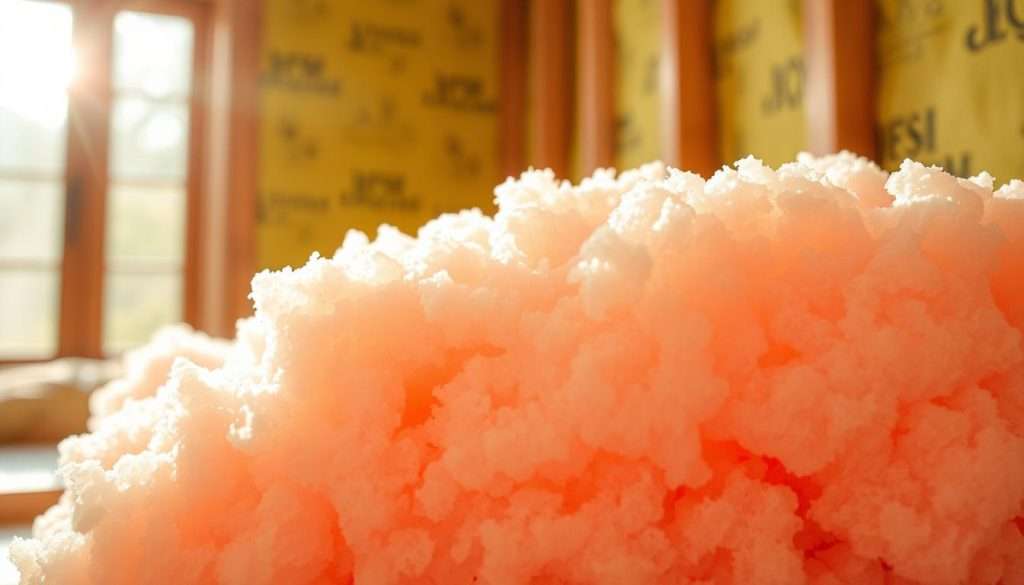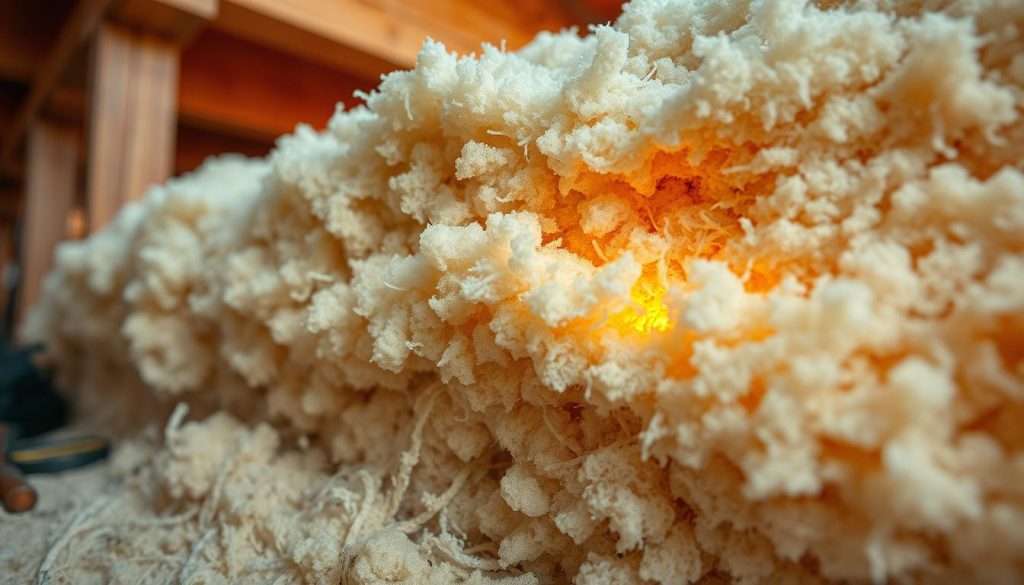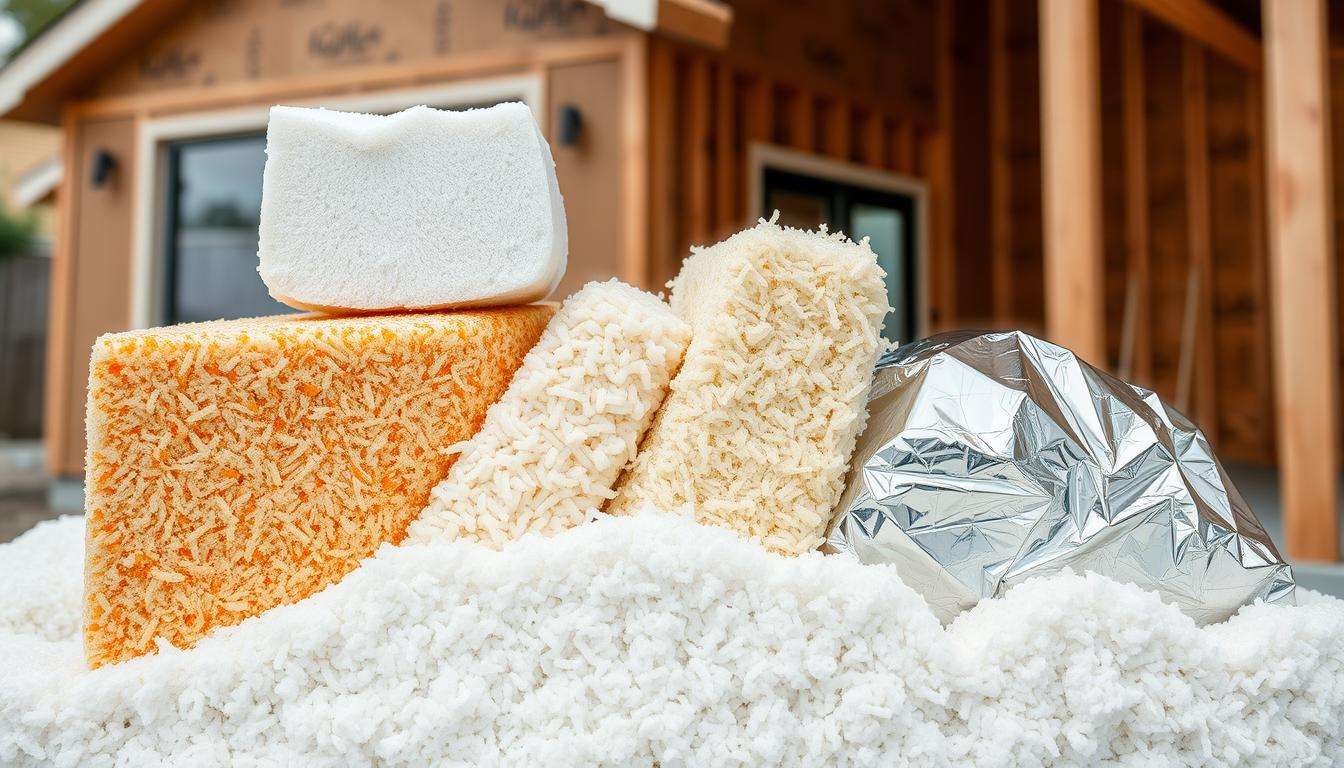Are you wondering what insulation is made of? It’s important for keeping your home comfy. Insulation stops heat from moving around, keeping your space cozy. This guide will cover the main types of insulation, like fiberglass and foam, to help you choose the best for your home.
Insulation comes in many forms and types. We’ll look at each one to help you pick the right one for your home.
Key Takeaways
- Insulation keeps your home energy-efficient and comfy.
- Common insulation materials include fiberglass, foam, cellulose, and mineral wool.
- Types of insulation are based on how well they keep heat out or in.
- Knowing how insulation works is key to making the right choice.
- Choosing the right insulation can really save you money on energy.
Introduction to Insulation Materials
Knowing the importance of insulation is key for homeowners. It helps keep homes warm in winter and cool in summer. This makes homes more energy efficient and saves money on bills.
Importance of Insulation
Insulation does more than just keep us comfy. It’s also important for:
- Lowering energy use, saving money.
- Improving air quality by stopping drafts and moisture.
- Reducing noise, making homes quieter.
Overview of Insulation Types
There are many insulation types, each with its own benefits. Some common ones are:
| Insulation Type | R-Value (2×4 Wall) | Recycled Content |
|---|---|---|
| Fiberglass | R-15 | 40% to 60% recycled glass |
| Cellulose | R-15 | 82% to 85% recycled materials |
| Mineral Wool | R-15 | 75% post-industrial recycled content |
| Cotton | R-13 | 85% recycled cotton |
| Foam Board | R-5 to R-7 per inch | Varies by type |
Choosing the right insulation depends on your home’s needs and what you prefer. Learning about these insulation types helps you make smart choices for your home.
Common Insulation Materials
Understanding the different insulation materials is key. Each has its own benefits and uses. Let’s look at some common ones you’ll find.
Fiberglass
Fiberglass insulation is loved for its price and how well it works. It’s made of glass fibers that trap air and block heat. It has an R-value of 2.9 to 3.8 per inch, making it a solid choice.
It’s also good for the planet because it doesn’t soak up moisture. This stops mildew from growing.
Foam Board
Foam board insulation is great for keeping your home warm. It’s in rigid panels made from polystyrene or polyisocyanurate. It has an R-value of up to 6.3 per inch, which is very good.
Even though it’s not eco-friendly, it’s perfect for certain jobs. Like basement walls and exterior foundation insulation.
Cellulose
Cellulose insulation is eco-friendly and made from recycled paper. It has an R-value of 3.1 to 3.7 per inch. It’s good at keeping your home warm.
It’s treated to be fire-resistant, but it can still burn. So, it’s important to install it right. Its high recycled content makes it a green choice for many.
Mineral Wool
Mineral wool insulation is made from natural or recycled stuff. It’s great at fighting fires and keeping warm. It has an R-value of 2.8 to 3.5 per inch.
It’s good for the planet and doesn’t catch fire. This makes it safe for your home.
| Material | Price per sq. ft. | R-Value per inch | Environmentally Friendly | Flammable |
|---|---|---|---|---|
| Fiberglass | $ | 2.9 – 3.8 | Yes | No |
| Foam Board | $$$ | 6.3 | No | Yes |
| Cellulose | $$ | 3.1 – 3.7 | Yes | Yes |
| Mineral Wool | $$ | 2.8 – 3.5 | Yes | No |
Fiberglass Insulation: Properties and Uses
Fiberglass insulation has been used in homes since the 1930s. It’s made from plastic and tiny glass fibers. This makes it good for many uses.
Composition of Fiberglass
Fiberglass insulation is made of tiny fibers. These fibers help slow down heat, cold, and sound. It comes in different forms, like batts, which have a higher R-value.
The R-value shows how well something keeps heat out. Fiberglass usually has an R-value of 2.1 to 2.7 per inch. Walls often have R-values from 11 to 19. Ceilings can go up to R-30 to R-38.
Advantages of Fiberglass Insulation
- It’s affordable and helps save energy.
- It’s fire-resistant, which is good in emergencies.
- It lasts a long time and doesn’t settle or sag.
- It’s made from recycled materials, so it’s good for the planet.
- It can be installed in many places, like attics and walls.
- It doesn’t trap allergens, so it’s good for air quality.
Installation Techniques
Installing fiberglass insulation can be a fun DIY project. First, measure carefully to avoid waste. Wear gloves, dust masks, and safety glasses to stay safe from fiberglass.
Make sure to seal any gaps or cracks before you start. This helps the insulation work better.

| Property | Details |
|---|---|
| R-Value | 2.1 – 2.7 per inch; Common: R-11 to R-19 for walls, R-30 to R-38 for ceilings |
| Fire Resistance | Non-combustible materials help prevent flame spread |
| Allergen Control | Does not trap dust mites, pollen, or mold spores |
| Durability | Maintains effectiveness over time without significant settling |
| Environmentally Friendly | Made from recycled content, promoting sustainability |
Foam Insulation: Types and Applications
Foam insulation helps keep your home warm in winter and cool in summer. It fills gaps and acts as a strong barrier against heat. Knowing the difference between closed-cell and open-cell foam helps you choose the best for your home.
Closed-Cell Foam
Closed-cell foam is very good at keeping heat out. It has an R-value of about 6.2 per inch. Its cells are tightly packed, stopping air and moisture. It’s great for:
- Basements and foundations
- Roofing systems
- Exterior walls in extreme climates
It’s durable and saves a lot of energy, making it a top pick for many.
Open-Cell Foam
Open-cell foam is softer and more flexible, with an R-value of about 3.7 per inch. Its cells are connected, letting air through. It’s less dense and cheaper than closed-cell foam. It’s best for:
- Attics
- Interior walls for soundproofing
- Unvented roof assemblies
It’s not as good at keeping moisture out as closed-cell foam. But it still helps keep your home warm or cool.
| Type of Foam | R-Value (per inch) | Applications | Moisture Resistance |
|---|---|---|---|
| Closed-Cell Foam | 6.2 | Basements, roofing, exterior walls | High |
| Open-Cell Foam | 3.7 | Attics, interior walls, unvented roofs | Lower |
Understanding these two types of foam insulation helps you make the right choice. This ensures your home is well-insulated and energy-efficient.
Cellulose Insulation: Eco-Friendly Solution
Cellulose insulation is a green choice for homes. It’s made from recycled paper. This makes it great for saving energy and being kind to the planet.
What is Cellulose Made Of?
Most of cellulose insulation comes from recycled paper. This includes old newspapers and cardboard. It also has fire retardants like boric acid to keep homes safe.
Using recycled paper saves trees. Every day, millions of newspapers are thrown away in the U.S. If some were used for insulation, it could save many trees.
Benefits of Cellulose Insulation
Choosing cellulose insulation has many benefits. It’s a top pick for those who care about the environment:
- Energy Efficiency: It keeps homes warm or cool better than fiberglass. It has an R-value of R-3.1 to R-3.8 per inch.
- Soundproofing: Its density helps block sounds. This makes homes quieter.
- Environmentally Friendly: It’s mostly made from recycled materials. This makes it a green choice for building.
- Low VOC Emissions: It has very low levels of harmful chemicals. This improves air quality inside homes.
- Cost-Effective: Installing it costs about the same as fiberglass. It’s a good value for the price.
In short, cellulose insulation is a top choice for green homes. It’s made from recycled materials and works well. It’s a smart pick for building homes that are good for the planet.
| Feature | Cellulose Insulation | Fiberglass Insulation |
|---|---|---|
| R-Value | R-3.1 to R-3.8 per inch | R-2.2 to R-2.7 per inch |
| Recycled Content | 75-85% | Minimal |
| Cost per square foot | $0.90 – $1.50 | About $0.91 |
| Density | Higher density, better soundproofing | Lower density |
| Fire Retardants | Treated with boric acid | No specific treatment required |
Mineral Wool Insulation: Characteristics
Mineral wool insulation is special because of its mix and great features. It’s a top pick for building homes. Knowing about it helps you choose the right insulation.
Composition and Density
This insulation is made from rock wool and slag wool. Rock wool comes from stone fibers. Slag wool is made from iron ore waste.
It comes in different densities. This lets it meet many insulation needs. Lighter types keep warm well. Thicker types block sound and keep warm better.
Fire Resistance
Mineral wool insulation is very good at fighting fires. It can handle heat up to 1,800 degrees Fahrenheit. It stays strong and works well even when it’s hot.
This makes buildings safer by stopping fires from spreading. It also doesn’t soak up water. So, it keeps insulating well even when it’s wet.

It has a higher R-value than fiberglass batts. For example, R-15 for 2×4 walls. This means it keeps your home warmer.
Choosing mineral wool insulation means you’re picking something durable, effective, and safe. It’s great for your home.
| Category | Mineral Wool Insulation | Fiberglass Insulation |
|---|---|---|
| Fire Resistance | Up to 1,800°F | Ignites at 700°F |
| R-Value (2×4 walls) | 15 | 11 or 13 |
| Cost per sq. ft. | $0.80 | $0.60 |
| Recycled Content | 10-90% (depends on type) | 40-60% |
| Moisture Resistance | Does not absorb water | Can droop or compress when wet |
Reflective and Radiant Barrier Insulation
Reflective insulation and radiant barriers help keep your home cool. They work best in warm places. Knowing how they work helps you choose the right insulation for your home.
What Are Reflective Barriers?
Reflective barriers are made of aluminum foil. They reflect heat away from your home. This is great in places like Sacramento, where it’s hot.
To work best, they need a space to reflect heat. This space lets them do their job well.
- Common materials in reflective insulation include foil-faced kraft paper, plastic film, and polyethylene bubbles.
- Radiant barriers work best in homes with specific characteristics, such as:
- Air ducts located in attics
- Asphalt roofing that absorbs significant heat
- Minimal natural shade from surrounding trees
Applications and Efficiency
Reflective insulation works for homes and businesses. It helps in many ways:
- Reduces energy costs
- Makes homes more comfortable
- Is good for the environment
- Is easy to install and lasts long
- Is cost-effective
Aluminum foil radiant barriers reflect up to 97% of heat. This makes them very effective. Reflective insulation can have R-values from R-5 to R-10, depending on the foil layers.
Gold Star Insulation helps homeowners in Sacramento control their climate and save on energy. Reflective insulation reflects 94-97% of radiant heat. It makes homes more comfortable and efficient.
| Type of Reflective Insulation | Reflectivity (%) | Typical R-Value | Best Applications |
|---|---|---|---|
| Aluminum Foil | Up to 97% | R-2 or less (alone) | Residential attics with air ducts |
| Single Bubble | Up to 94% | R-5 to R-10 | Residential applications |
| Double Bubble | Varies | Higher values for commercial use | Commercial and industrial facilities |
Choosing the Right Insulation Material
Choosing insulation is more than picking a product. You need to think about many things for the best results. Knowing your options helps you pick the right one for your home. This way, you get good insulation without spending too much.
Factors to Consider
- Location: The U.S. Department of Energy says different insulation levels for different climates. In the south, you need 13-14 inches (R-38). In the north, 16-18 inches (R-49) is best.
- Material Type: There are many types of insulation. Some need special ways to install, like using paper or foil to keep moisture out.
- Installation Skill: Some insulation you can do yourself. But, some like sprayed foam need a pro. Knowing your skills helps plan your insulation.
- Environmental Impact: Choosing ENERGY STAR products means you get quality and help the planet. For example, cellulose insulation pulls carbon dioxide out of the air.
Cost vs. Performance
Your budget should match your insulation goals. Insulation prices vary a lot. For example:
| Insulation Type | R-Value per Inch | Typical Cost | Carbon Emissions (kgCO2e/m2) |
|---|---|---|---|
| Fiberglass | R-3.1 to R-4.2 | Low | 1.2 – 1.8 |
| Cellulose | R-3.2 to R-3.8 | Low | -1.8 |
| Mineral Wool | R-2.9 to R-4.3 | Moderate | 4.7 – 5.1 |
| Spray Foam | R-5.0 to R-6.5 | High | Varies |
By looking at cost and performance, you can make smart choices. Think about what you need and what you can afford. Pick insulation that’s both affordable and effective.
Conclusion: The Future of Insulation Materials
As we move forward with green building, today’s insulation is key. It makes buildings better and lasts longer. We see new materials like aerogels and bio-based ones. They keep buildings warm and cool, and they’re good for the planet.
People want thin insulation that works well and lasts. They care about how materials perform and how long they last.
Innovations in Insulation Technology
Insulation materials are changing fast. Products like SteicoFlex and Cosywool are leading the way. They are eco-friendly and made from renewable stuff.
There’s a big push for products that save energy. The Thermablok Aerogel Insulation Blanket is a great example. It’s full of air to keep buildings warm or cool better. This helps fight climate change and saves money on energy.
Sustainable Options and Trends
The insulation world is moving towards better energy use. It wants to make buildings comfy and clean. EcoCocon Wall Panels and Gutex Thermofloor boards show this trend.
They use natural stuff that helps the planet. Looking ahead, we’ll see more of these green options. They’ll meet demand and make buildings eco-friendly and efficient. For more on this, check out this guide on advanced insulation materials.
